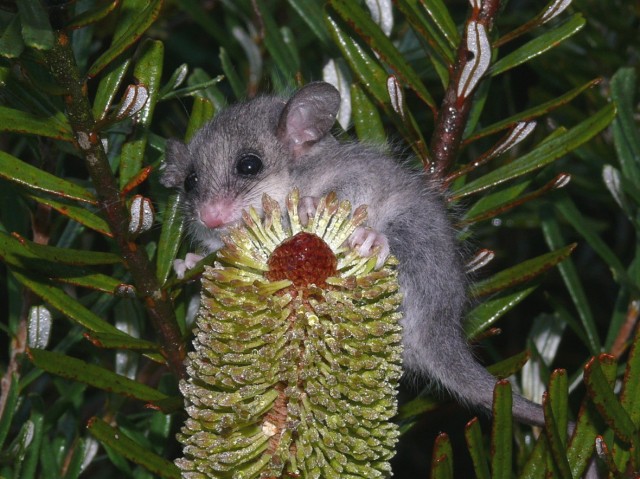Australia’s eastern pygmy possums can smell smoke from an approaching fire during their winter hibernation but will only wake and try to flee danger if there’s a significant temperature increase, according to research at the University of New England in New South Wales.

It’s the first study of its kind to investigate the impact of smoke and fire on hibernating animals, and the first to show that animals can smell during this state of winter torpor.
And it has some serious implications for future management of fuel reduction burning in Australia during autumn and winter.These burns are conducted by state authorities and local councils to reduce flammable fuel loads for spring and summer bushfires.
But more about that shortly. Eastern pygmy possums (Cercartetus nanus) live in eucalypt forests and banksia heathlands along the country’s southeastern coast, from southern Queensland to eastern South Australia and Tasmania.
These are nocturnal, mouse-sized possums that weigh between 10 and 40 grams (so, about the same as a handful of almonds & way less than half a punnet of blueberries). They live in nests of bark and leaf litter in tree hollows or abandoned birds nests, and are agile climbers. They feed on nectar and pollen, mainly from banksia and callistemon flowers.
Yes, they’re impossibly cute – but no, they’re not the ones you’ve probably seen in a popular Facebook meme, clinging to a human thumb, with the caption “Not Everything in Australian is Trying to Kill You.” That’s the western pygmy possum (C. concinnus).
The UNE study was led by Dr Julia Nowack, an ecophysiologist who’s been studying how animals use torpor to survive and cope with natural disasters such as violent storms and bushfires.
It involved five eastern pygmy possums (three males, two females) captured in traps and nesting boxes in Guy Fawkes National Park, near the town Dorrigo, on the NSW northern tablelands.
Tests were conducted while the animals were in a state of topor, to find out if they could smell smoke while in hibernation and whether they could wake to climb onto a branch and move away from an approaching fire (or at least, in laboratory conditions, what smelled like the threat of fire).
The results are published online in the Springer journal, The Science of Nature.
“We tested whether hibernators in deep torpor (a) can respond to the smell of smoke and (b) can climb to avoid fires,” the research paper says.
The study found that all the pygmy possums were able to smell the smoke, but didn’t move until temperatures increased from 10 degrees Celsius to 15 degrees.At that point, the males were “aroused from torpor”, whereas the female pygmy possums “only lifted their heads.”
Its says that the “first coordinated movement of possums along a branch” was observed at around of 15.6 °C , and possums were “able to climb their prehensile tail” when their body temperatures reached around 24 °C.
But is this enough effort to save them from a fire?
The study says that although all five pygmy-possums responded to the smell of smoke and higher temperatures, “one animal re-entered torpor immediately after the arousal, while the females did not arouse at all and only showed a behavioural response.”
“This indicates that more cues than just the smell of smoke are necessary to mimic an approaching fire,” it says.
“Arousal from torpor in response to the smell of smoke does not suffice and will not guarantee the survival of the individual when the animal cannot also move quickly enough to evade the danger.”
So, the experiment has shown that pygmy possums hibernating during winter could smell smoke from a prescribed burn, and might be able to wake and climb to safety as – and if – temperatures increase.
“We can assume that if torpid animals are present in an area of a burn, they are able to arouse before the fire has reached their nest location and have the chance to seek a safe refuge during the fire.
“However, if deaths of small mammals due to fires are to be minimised, prescribed burns should not be conducted during the coldest part of winter,”the study says.
